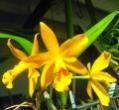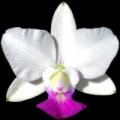


Donate Now
and become
Forum Supporter.

Many perks!
<...more...>


|

09-13-2021, 12:43 PM
|
|
Banned
|
|
Join Date: Apr 2021
Posts: 1,247
|
|

I just saw someone else post a similar demise on another forum which makes me believe the gigantea is far more sensitive than other phals.
Now I honestly don't want to threadbomb this thread, it seems to have exploded in activity recently but to me the original fertilization requirements are the problem people are facing.
I don't know how some people manage to fertilize so heavily on some of their mini's. I won't speculate on that but I feed my mini's 25ppm N maximum.
I know for a fact that Vanda's, Dendrobiums and even Cymbidiums can do fine with 25 ppm N per watering, Phalaenopsis anyway. They do benefit from a bit more once they are bigger but 25ppm is enough to sustain any orchid for at least a year at which point possibly heavy feeders will show signs that they want a little more.
A little more being up to 50 ppm max.
The care guide says at the beginning to feed up to 125 ppm N and recommends doubling that in hot weather.
ES, I won't speculate what happened with yours but I know you like to fertilize the heaviest out of everyone I know on here going up to 1000ppm in total for your Vanda's so if you were following the recommended dosages, my money would be on that concentration doing damage.
Also the statement of I did this but it can't have been that because the orchid did not die for another 2 months means very little as it routinely takes orchids 2 months to die. They don't just drop dead overnight. Any changes take a couple of months to mark the ultimate demise although I agree that dryness is probably less of a factor than feeding wrong if you compare the culture to nature grown plants.
I know there are millions of discussions on fertilizers and at the end of discussing it for days we all just go back to doing what we always do - feed vanda's at 1000ppm or whatever else we have been doing.
Just to put it in perspective every single flower I have shown this year has been grown with 25 ppm N max.
I know I'm still a bit of a novice with only 40 orchids flowered so far. Some people have been growing for 40 years and would disagree with me.
The point I am trying to make is that maybe, just maybe a Gigantea is more sensitive than other phals.
So if you have flowered 1000 phals, you might then end up failing every time with a Gigantea.
That's my 2 cents on the matter. Why use 5 times as much as another grower who succeeds with 5 times less fertilizer. That is a big difference to me. I know most phals can tolerate such a wide variance as orchids consume so little anyway but with the more sensitive ones it might make a bigger difference.
I honestly want to know why the Gigantea's that don't make it with people at home ultimately don't make it. Other phals have no problem growing indoors and my comments aren't just plucked out of thin air.
They are just a theoretical observation and I don't want to cause upset, I want to play detective, to me dryness can't be too bad, cold temps don't seem to affect it too much, air flow and light can be provided. Maybe I am off on this, I know some people think it makes no difference to the health of a phal and maybe with most phals it really doesn't as they can tolerate either but a Gigantea seems to be a bit different to other phals.
What do you think? Has anyone here been feeding over 100ppm N - and just to clarify if one feeds 100pm N that means one has to be feeding an overall concentration of roughly 500ppm in total fertilizer.
If so, has the plant been able to handle it ok?
Conversely has anyone tried feeding it 25ppm N, so 125ppm total fertilizer concentration? What has been the result? Healthy growth or signs of deficiencies?
When I think of the name Gigantea, I think that it would need a giant amount of fertilizer to make it big and strong. But that ultimately might be causing problems?
Last edited by Shadeflower; 09-13-2021 at 01:00 PM..
|

09-13-2021, 01:41 PM
|
 |
Senior Member
|
|
Join Date: Jun 2015
Zone: 9b
Location: Phoenix AZ - Lower Sonoran Desert
Posts: 19,168
|
|
I use around 25 ppm nitrogen for Phals and most other orchids. I haven't fertilized anything much this summer. Vandas get the highest amounts.
|
|
Post Thanks / Like - 1 Likes
|
|
|
|
|

09-14-2021, 11:17 AM
|
 |
Senior Member
|
|
Join Date: Feb 2021
Zone: 8b
Location: Dusseldorf, DE
Posts: 1,216
|
|
well, sorry also to threadbomb, but the starship landed quite a bit sooner than expected! our newest phal, gigantea starship x self. hopefully we can keep it alive, as it was our most expensive orchid x 10. and also hopefully one day we can post up a bloom pic from it....
|
|
Post Thanks / Like - 6 Likes
|
|
|
|
|

09-14-2021, 12:02 PM
|
|
Banned
|
|
Join Date: Apr 2021
Posts: 1,247
|
|
Quote:
Originally Posted by tmoney

well, sorry also to threadbomb
|
That was me while I was probably overthinking things so just ignore me when that happens, you are the star of this ship now. That is a seriously good looking gigantea |
|
Post Thanks / Like - 1 Likes
|
|
|
|
|

09-14-2021, 12:10 PM
|
|
Senior Member
|
|
Join Date: Jul 2020
Age: 29
Posts: 701
|
|
Quote:
Originally Posted by tmoney

well, sorry also to threadbomb, but the starship landed quite a bit sooner than expected! our newest phal, gigantea starship x self. hopefully we can keep it alive, as it was our most expensive orchid x 10. and also hopefully one day we can post up a bloom pic from it....
|
Naaah I can see it's a total dud, you won't ever get flowers from that.
I'll help you get rid of it, should you need to. |
|
Post Thanks / Like - 1 Likes
|
|
|
|
|

09-14-2021, 12:48 PM
|
 |
Senior Member
|
|
Join Date: Feb 2021
Zone: 8b
Location: Dusseldorf, DE
Posts: 1,216
|
|
Quote:
Originally Posted by Shadeflower

That was me while I was probably overthinking things so just ignore me when that happens, you are the star of this ship now. That is a seriously good looking gigantea
|
hahaha, well we can rename it the shooting star if and when it dies or doesn’t do much! im not gonna lie im concerned over out temp abilities this winter, so yeah, some adjustments around the house are happening that we hope will get us a little closer to the mark. basically i hope this isn’t the best it looks and good things are to come 🙈 |

09-18-2021, 03:15 PM
|
 |
Senior Member
|
|
Join Date: Sep 2020
Zone: 8a
Location: Central Mississippi
Posts: 653
|
|
There are sources that advocate foliar feeding for Phalaenopsis gigantea saying it doesn't tolerate salts in the root zone. I'm not saying that SIPGDS (Suddent Infant Phalaenopsis gigantea Death Syndrome) was caused by fertilizer, but only putting this out there not knowing if it is true or untrue. As I said, there's a lot of contradictory information about growing this species.
There are also growers who speak of difficult and easier strains.
-Keith
__________________
+++++++++++
|

09-18-2021, 04:12 PM
|
 |
Senior Member
|
|
Join Date: Jun 2015
Zone: 9b
Location: Phoenix AZ - Lower Sonoran Desert
Posts: 19,168
|
|
I may try again but not at $50. Shoot, when I was a kid a big chocolate bar was a nickle. That's 5 cents in metric.
|

09-18-2021, 04:18 PM
|
|
Senior Member
|
|
Join Date: Jul 2020
Age: 29
Posts: 701
|
|
Seeing how thick and waxy the cuticle of gigantea is, I wouldn't think foliar feeding would work really well.
Maybe on the deciduous Phal, that have a very different leaf structure.
|

09-18-2021, 04:25 PM
|
 |
Senior Member
|
|
Join Date: Jun 2015
Zone: 9b
Location: Phoenix AZ - Lower Sonoran Desert
Posts: 19,168
|
|
I've read the same article KSci has about foliar feeding of seedlings and differing vigor among strains. I think it's the Peter Lin article I mentioned, which I could not find on his Web site, but found at archive.org. Peter certainly knows more about Phals than I do.
|
|
Currently Active Users Viewing This Thread: 5 (0 members and 5 guests)
|
|
|
 Posting Rules
Posting Rules
|
You may not post new threads
You may not post replies
You may not post attachments
You may not edit your posts
HTML code is Off
|
|
|
All times are GMT -4. The time now is 12:57 AM.
|
































 Linear Mode
Linear Mode


